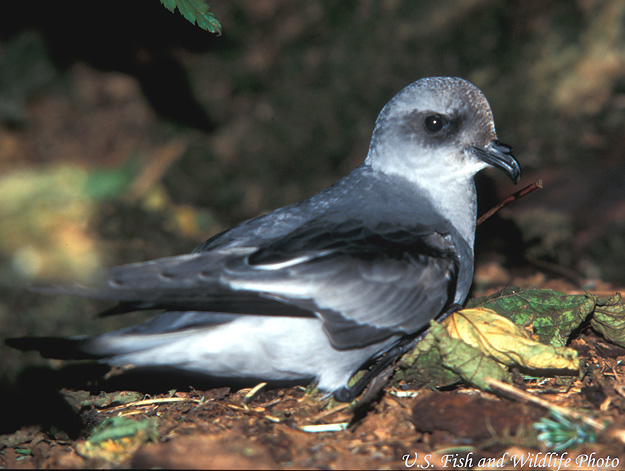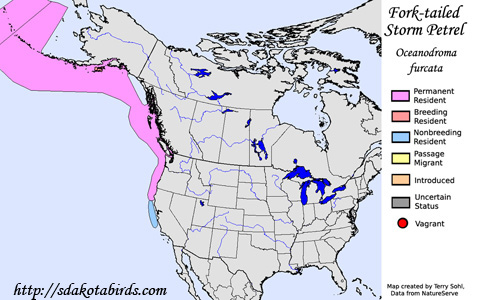| Length: 8.5 inches | Wingspan: 19 inches | Seasonality: Non-resident in South Dakota |
| ID Keys: Silvery-gray plumage overall, forked tail, dark markings on underwing coverts and parts of upper wings | ||
 The
Fork-tailed Storm-Petrel is readily distinguished from other Storm-Petrel
species, as it is the only Storm-Petrel that is gray overall, rather than
mostly black. They are common in the North Pacific, particularly
around Southern Alaska. Smaller numbers may be found as far south as
coastal Washington and Oregon, and in some winters, there are outbreaks of
Fork-tailed Storm-Petrels as far south as southern California.
The
Fork-tailed Storm-Petrel is readily distinguished from other Storm-Petrel
species, as it is the only Storm-Petrel that is gray overall, rather than
mostly black. They are common in the North Pacific, particularly
around Southern Alaska. Smaller numbers may be found as far south as
coastal Washington and Oregon, and in some winters, there are outbreaks of
Fork-tailed Storm-Petrels as far south as southern California.
Habitat: Nests on islands with significant amounts of vegetative cover. Outside of the nesting season, may be found fairly close to land, or far out to sea. In winter, they may be found as far north as open water is found.
Diet: Feeds mostly on small fish and crustaceans. They will also sometimes feed on carrion, and will skim oily residues from the water's surface that are left by whale or other large marine mammal carcasses.
Behavior: Forages by taking food form the surface of the water, mostly by hovering over the ocean's surface and plucking food items with its bill. They will also sometimes swim on the ocean's surface and pick up food items while swimming.
Nesting: The Fork-tailed Storm-Petrel excavates a burrow in soft soil, or uses natural cavities such as crevices in rocks, or burrows built by other animal species. The nest itself may consists of a small amount of grass or other vegetative material, or no formal nest may be constructed. The female lays a single egg, which is incubated by both the male and female. Once the young hatches, both parents feed it, with the young typically fledging from the nest at about 2 months of age.
Song: At breeding locations, adults have a mellow trilling sound, as well as harsher, high-pitched notes. They are usually silent away from their nest site.
Migration: Not truly migratory, as birds are present over their breeding range at all times of the year. However, variable numbers of Fork-tailed Storm-Petrels move further southward along the U.S. West Coast in the winter, with birds sometimes reaching as far south as southern California.
Interactive eBird Map: Click here to access an interactive eBird map of Fork-tailed Storm-petrel sightings
Similar Species: The Fork-tailed Storm-Petrel is the only Storm-Petrel that is gray all over. Other Storm-Petrel species are typically mostly black.
Conservation Status: Populations of Fork-tailed Storm-Petrels are large, may be increasing, and they are found over a large geographic range. The IUCN lists the Fork-tailed Storm-Petrel as a species of "Least Concern".
Further Information: 1) Alaska Seabird Information Series - Fork-tailed Storm-Petrel
2) WhatBird - Fork-tailed Storm-Petrel
3) Audubon Guide - Fork-tailed Storm-petrel
Photo Information: Photo from U.S. Fish and Wildlife Service (public domain)
| Click below for a higher-resolution map |
 |
| South Dakota Status: Non-resident in South Dakota |
Additional Fork-tailed Storm-Petrel Photos (coming soon!!)
